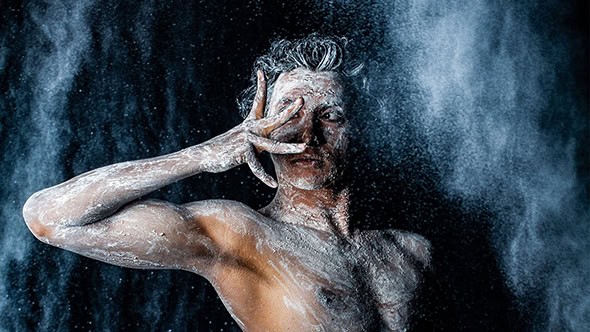Seeta Patel’s re-imagining of The Rite of Spring
Posted: May 20th, 2019 | Author: Nicholas Minns & Caterina Albano | Filed under: Performance | Tags: Anshu Arora, Ash Mukherjee, Celine Lepicard, Igor Stravinsky, Indu Panday, Jason Cheriyan, Julien Kottukapally, Kamala Devam, Moritz Zavan, Sarah Gasser, Seeta Patel, Sooraj Subramaniam, Talvin Singh, Warren Letton | Comments Off on Seeta Patel’s re-imagining of The Rite of SpringSeeta Patel’s re-imagining of The Rite of Spring, The Place, May 17

In 1913, when Vaslav Nijinsky was starting to choreograph a new work by the young composer Igor Stravinsky, Serge Diaghilev hired a eurythmics student, Marie Rambert, to assist his protégé with counting the score. The new ballet was The Rite of Spring which famously premiered in Paris in May of that year. After a mere eight performances, Nijinsky’s choreography was lost for almost 70 years until Millicent Hodson painstakingly reconstructed it for the Joffrey Ballet in 1987, but since the latter half of the twentieth century Stravinsky’s celebrated score has become a rite of passage for choreographers eager to challenge the rich complexity of its musical structure. Seeta Patel is the latest to tackle the score but she is perhaps one of the first to formulate her response through the Indian classical dance form of Bharatanatyam. It’s a revelation.
Patel is known for her exquisite solo work but she has also devoted her considerable artistic intelligence to dealing with issues of identity that affect her as an artist and Bharatanatyam as a traditional dance form, from her film with Kamala Devam, The Art of Defining Me, to her dark cultural fable created with Lina Limosani, Not Today’s Yesterday. While her work remains firmly anchored in the Bharatanatyam technique, she has also begun to explore collaborations with complementary art forms, notably in Sigma with Gandini Juggling where her mastery of both rhythm and gesture complement the mathematical precision of the jugglers. In the process she is subtly moving Bharatanatyam away from its original context to reinvent it in a contemporary idiom. This process has reached a new level of maturity in her re-imagining of The Rite of Spring; everything she has struggled to achieve has come to fruition.
Patel approached what she calls ‘this beast of a score’ by studying Stravinsky’s rhythms with pianist Julien Kottukapilly which she then translated into a carnatic vocabulary with which her dancers could identify. This attention to a score until it becomes embodied — similar to the way Anne Teresa de Keersmaeker approaches her work — is to enter into the music by the same door as the composer; only then is it possible to deliver a response that is true to its structure. To see Patel’s choreography is to hear The Rite of Spring in a new cross-cultural perspective.
The original score is subtitled ‘Pictures of Pagan Russia in Two Parts’, a scenario devised by Nicholas Roerich who also designed the original costumes and scenery. Patel initially follows Roerich’s outline; in the first part, she writes, ‘the excitement is palpable, the dancers still youthful and full of hope, being pushed and pulled by the energy around them.’ The energy is in the music and Patel opens up a dynamic spatial world within it by defining geometric pathways for her dancers. From the opening languorous poses that pay homage to Nijinsky’s faun she builds up the suggestion of a community waking up and setting out into the fields in a spirit of worship. Using Bharatanatyam’s vocabulary of complex rhythmical coordination punctuated by eloquent hand gestures, facial expressions and precise percussive footwork her six dancers — Ash Mukherjee, Indu Panday, Kamala Devam, Moritz Zavan, Sarah Gasser and Sooraj Subramaniam — make the intricacy of the musical textures and rhythms visible while maintaining their ritual allusions.
Separating the two parts of the score with a brief vocalised interlude, Patel then inverts Roerich’s idea of the Chosen One as sacrificial victim; it is the community who chooses a leader to whom they cede their autonomous power. The tall, imposing Subramaniam is deified, wrapped in blood-red trappings and at the score’s final chord of sacrificial exhaustion he is the one remaining upright spiralling slowly into his trailing adornments as the community crouches behind him in his shadow.
The setting for this re-imagining is a bare white stage with a white backdrop; the element of scenery is subsumed in Warren Letton ’s subtle washes of colour and in the luminous silk costumes and elaborate makeup of Jason Cheriyan and Anshu Arora. So closely do all the elements of this creation align with the music that it appears effortless; whatever orchestral forces Stravinsky throws at her, Patel transforms them into a field of light.
The evening begins with Patel’s Dance Dialogues, a short choreographic conversation between six young performers trained in either Bharatanatyam or contemporary dance. The music is by Talvin Singh with live accompaniment by cellist Celine Lepicard who bridges the two choreographic works with a recital of Bach’s first cello suite.